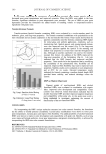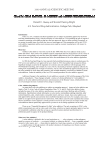SUNLESS TANNING FORMULATIONS 81 natural suntan, while another panelist seemed to have less red than natural suntan. The tonality of the sunless tan generated by K was less “natural” since three out of fi ve panel- ists were outside the “natural universe of suntan tonality” range. K also produced the following results based on ΔC* and ΔL* measurements: one of the fi ve panelists was out- side the “natural universe of suntan tonality” range and another panelist had a less devel- oped tan that was on the borderline of the range (Figure 7). Figure 5. Impact of the test articles on ΔE*ab values in vivo vs time. Figure 6. Impact on color response in vivo at 24 hours.
JOURNAL OF COSMETIC SCIENCE 82 CONCLUSIONS In vitro data suggest that different in vivo performances are expected for two dihydroxyac- etone (DHA)-containing formulations with similar concentrations of DHA and excipi- ents but different commercially available rheology modifi ers: one with a cationic polymer-based rheology modifi er (blend) [dimethylacrylamide/ethyltrimonium chloride methacrylate copolymer (and) propylene glycol dicaprylate/dicaprate (and) PPG-1 tride- ceth-6 (and) C10-11 isoparaffi n] and the other with a polyacrylamide-based rheology modifi er (blend) [polyacrylamide (and) C13-14 isoparaffi n (and) laureth-7]. These rheol- ogy modifi ers were used at 3% w/w (as supplied) and contained comparable concentra- tions of active polymers. In the followup in vivo studies, the test article with the cationic polymer-based rheology modifi er produced a more natural sunless tan, comparable to a desirable sun-induced tan, for all panelists the sunless tan was also more uniform and lasted longer compared with the sunless tan generated by the test article with the poly- acrylamide-based rheology modifi er. Panelists noticed a slightly less intense color devel- opment after application of X within the fi rst 24 hours, but the color of the tan was more even compared to that from K. These visual observations were confi rmed instrumentally: the average standard deviation of ΔE*ab for the panelists after 24 hours was 4.2 times higher for K than that for X. At 48 hours the ΔE*ab vs time trend was reversed, with slightly higher values for X than K. Apparently the fading of the sunless tan occurred at a slower rate with X than with K. Color associated with X was still visible with the “naked eye” after 120 hours for four panelists and for only one panelist with K. This indicates poten- tially better longevity of the tan generated by X compared to K, which may be attributed to the presence of the cationic polymer-based rheology modifi er (blend) in X. Overall, X produced a sunless tan color more consistent with the “natural universe of suntan tonal- ity” range, except for one panelist whose color was outside the range, but four other pan- elists had similar color responses and were well within the range. Figure 7. ΔC* and ΔL* values in vivo at 24 hours after application.
Purchased for the exclusive use of nofirst nolast (unknown) From: SCC Media Library & Resource Center (library.scconline.org)





































































































































